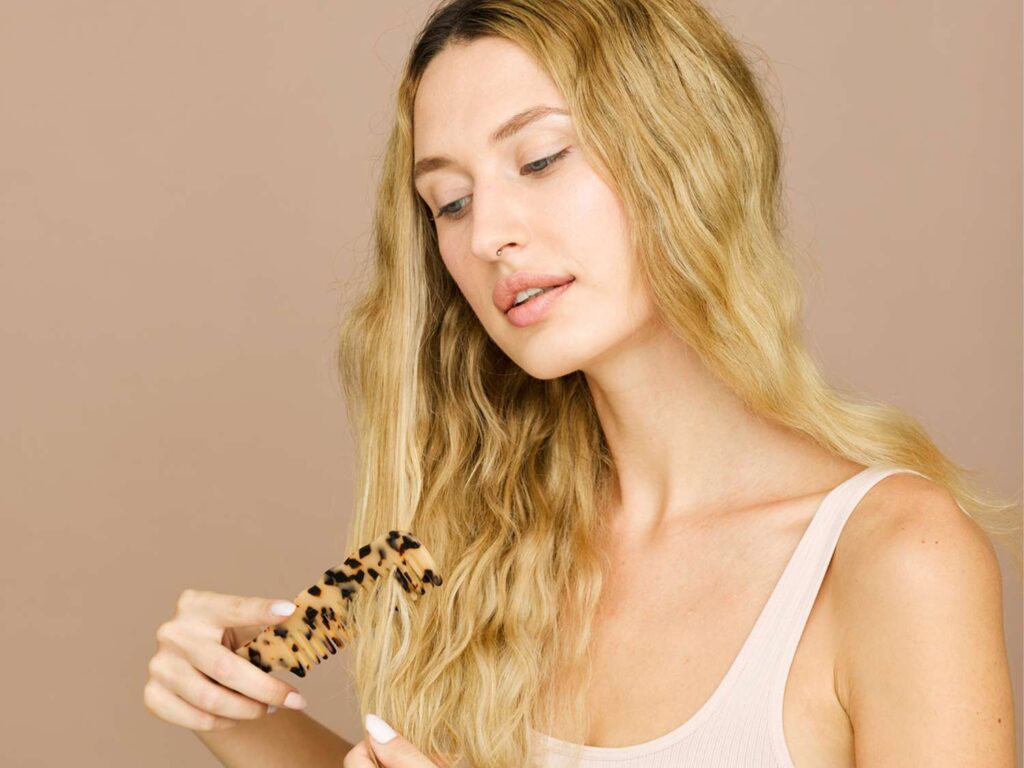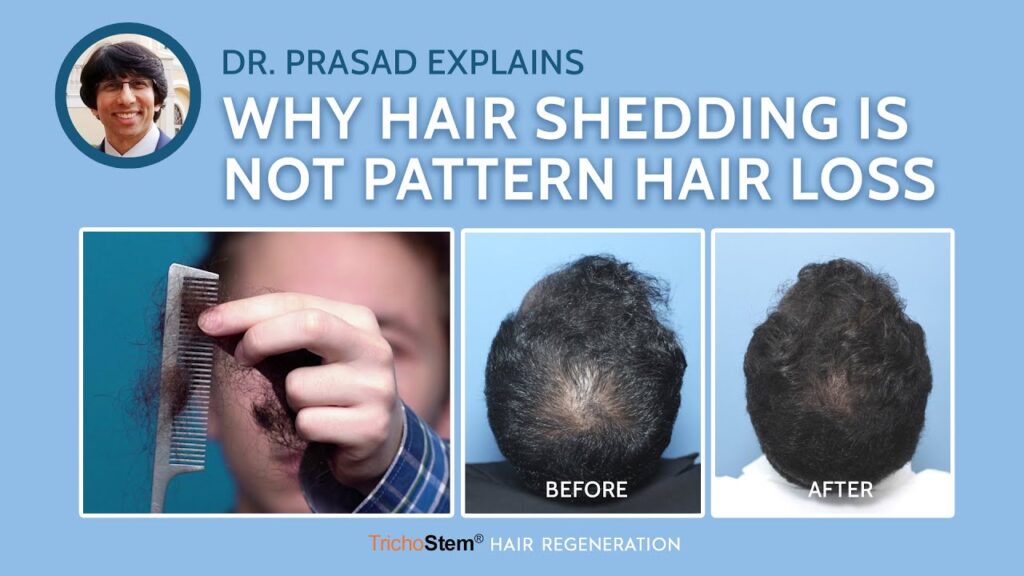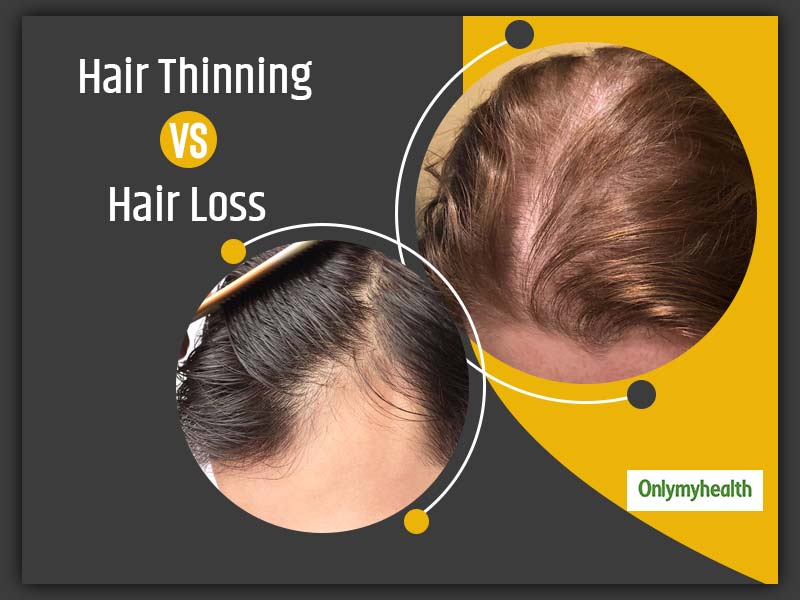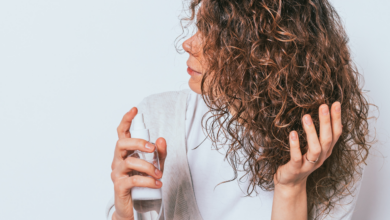
Hair shedding and hair loss are two distinct conditions that often get confused with each other. Understanding the difference between the two is crucial for proper diagnosis and treatment. Hair shedding is a natural part of the hair growth cycle, where strands naturally fall out to make room for new growth. Typically, we shed approximately 150 hairs daily, and this shedding reflects the initiation of a new life cycle. On the other hand, hair loss occurs when the strands stop participating in the normal growth cycle and fall off the scalp without reactivating the growth phase. Factors such as stress, diet, hormonal changes, and medical conditions can contribute to hair loss.
It’s important to seek professional help if you experience unexpected hair loss or prolonged excessive shedding accompanied by thinning or tenderness, as they may indicate underlying health issues that require treatment. In the meantime, practicing regular scalp care, avoiding heavy oils, limiting daily shampooing, and giving yourself a daily scalp massage can help maintain hair health and balance the hair growth cycle.
Understanding the Difference Between Hair Shedding and Hair Loss
Hair is often a defining aspect of our appearance and plays a significant role in our self-esteem and confidence. So, when we notice changes in our hair, such as shedding or loss, it is only natural to feel concerned. However, it is crucial to understand the difference between hair shedding and hair loss and when it is necessary to seek professional help. In this article, we will explore the distinctions between hair shedding and hair loss, common causes and factors, and provide tips for maintaining healthy hair.

Hair Shedding vs. Hair Loss
Hair shedding and hair loss are two terms that are often used interchangeably, but they refer to different phenomena. Hair shedding is a normal and cyclical process, while hair loss indicates a more severe and prolonged issue. Understanding the distinction between the two can help us determine when to seek professional assistance.
Hair shedding is a regular occurrence and is a natural part of the hair growth cycle. On average, individuals shed approximately 150 hairs daily. This shedding reflects the initiation of a new life cycle for the hair strands. The hair growth cycle consists of four stages: growth (anagen), transition (catagen), rest (telogen), and shedding (exogen). Shedding allows space for new hair growth, ensuring a healthy and continuous hair cycle. The transition from the shedding phase (exogen) to the growth phase (anagen) typically takes two to five months.
Hair loss, on the other hand, occurs when the hair follicles stop producing new hair, leading to a decrease in hair density and potentially resulting in bald patches. Hair loss can be triggered by various external or internal factors, such as hormonal imbalances, certain medications, nutritional deficiencies, genetics, and autoimmune conditions like alopecia areata. It is essential to consult a professional to diagnose the specific cause and determine the appropriate treatment plan.
When to Seek Professional Help
While some amount of hair shedding is a natural process, certain signs may indicate a need for professional evaluation. Any unexpected hair loss or prolonged excessive shedding should be evaluated by a dermatologist or a trichologist. If you notice a visible thinning of your hair or experience scalp sensitivity or tenderness, these could be indicators of hair loss rather than normal shedding. Consulting a professional can help identify the underlying cause and develop an effective treatment plan.
In some cases, hair shedding may be linked to dietary changes or hormonal imbalances. Consulting an endocrinologist can provide valuable insights and guidance in such situations. It is essential to seek professional help to address the root cause and ensure the best course of action.
What Is Hair Shedding?
Hair shedding is a regular and expected process in the hair growth cycle. As mentioned earlier, shedding is a crucial stage that allows for new hair growth. Our hair naturally sheds approximately 150 hairs daily, creating space for fresh growth. The hair growth cycle consists of four stages: growth (anagen), transition (catagen), rest (telogen), and shedding (exogen).
During the shedding phase (exogen), the hair strand is released from the hair follicle and falls out. This natural process enables the initiation of the growth phase (anagen), where new hair strands begin to develop. The transition between the shedding phase and the growth phase can take several months. It is important to note that hair shedding is a normal occurrence and does not necessarily indicate a problem.
What Is Hair Loss?
Hair loss occurs when the hair follicles stop producing new hair altogether. This can result in a decrease in hair density and the development of bald patches. Unlike hair shedding, hair loss is a more significant and often prolonged issue. It can be caused by various factors, including hormonal imbalances, certain medical conditions, genetic predisposition, stress, and autoimmune disorders.
Factors that can contribute to hair loss include cancer, radiotherapy, and severe diets. Some forms of hair loss, such as alopecia areata, can result in distinctive bald patches on the scalp. Understanding the cause of hair loss is crucial in determining the appropriate treatment plan.

Meet the Expert
When it comes to understanding hair shedding and hair loss, consulting experts in trichology can provide valuable insights and guidance. Trichologists specialize in the scientific study of hair and scalp health. Here are some renowned trichologists you can consider seeking advice from:
- Mark Constantine: Mark Constantine is a trichologist and the co-founder of Lush, a cosmetics company known for its natural and ethical hair care products.
- Dr. Isfahan Chambers Harris: Dr. Isfahan Chambers Harris is a trichologist and the founder of alodia, a brand focused on hair and scalp health.
- Kerry E. Yates: Kerry E. Yates is a trichologist and the founder of Colour Collective, a brand that provides comprehensive hair and scalp consultations.
Consulting with these experts can help you gain a deeper understanding of your specific condition and receive personalized recommendations for addressing hair shedding or loss.
Hair Shedding is a Regular Occurrence
Understanding the normal range of hair shedding is crucial to differentiate it from hair loss. It is estimated that an average person sheds approximately 150 hairs per day. This shedding is part of the natural hair growth cycle and is necessary for new hair strands to grow. The hair growth cycle consists of the anagen (growth), catagen (transition), telogen (rest), and exogen (shedding) phases. Each hair strand goes through these stages independently, ensuring a constant turnover and renewal of the hair.
Shedding is an essential process that creates space for new growth. When one hair strand is shed, another takes its place, following the natural cycle. Understanding this cyclical nature of hair shedding can help ease concerns about everyday hair loss.

Hair Loss Occurs when the Strands Stop Participating in the Life Cycle
Unlike hair shedding, hair loss occurs when the hair follicles cease to produce new hair altogether. In cases of hair loss, the hair follicles become inactive, leading to a decrease in hair density and potentially resulting in visible bald patches. Hair loss can be triggered by various factors, ranging from hormonal imbalances to medical conditions and lifestyle factors.
Certain medical treatments, such as cancer treatments like radiotherapy, can accelerate hair loss. Severe diets that lack essential nutrients can also contribute to hair loss. Differentiating between permanent and temporary hair loss depends on the underlying cause. For example, menopause-related hair loss is typically permanent, while hair loss caused by other factors can be temporary.
Factors that Contribute to Hair Loss
Hair loss can be attributed to various factors, and understanding them can help in identifying the root cause and developing an appropriate treatment plan. Causes of hair loss can vary significantly from person to person. Hormonal changes, such as those experienced during menopause, can contribute to permanent hair loss. Additionally, genetics, certain medical conditions, nutritional deficiencies, and lifestyle factors like stress can impact hair health and lead to hair loss.
For a comprehensive diagnosis and treatment plan, consulting a dermatologist or trichologist is recommended. They can evaluate your specific situation and provide personalized advice.

Preventative Tips for Maintaining Healthy Hair
While some causes of hair loss may be beyond our control, there are preventive measures we can take to maintain healthy hair. Incorporating these practices into our daily routine can help promote scalp health and reduce the risk of excessive shedding or hair loss.
- Daily Scalp Massages: Giving yourself a daily scalp massage for at least four minutes can relieve tension, improve blood circulation, and promote overall scalp health. Studies have shown that scalp massages can help decrease hair fall.
- Avoid Heavy Oils on the Scalp: Applying heavy oils directly to the scalp can clog hair follicles, hindering future hair growth. Opt for lighter hair products that nourish without weighing down the scalp.
- Limit Shampooing: Washing your hair every other day, instead of daily, can help maintain the natural oils on your scalp. Stripping cleansers can cause dryness and scalp irritation, which can contribute to hair loss. Finding a suitable shampoo for your hair type and needs is crucial.
By implementing these preventive tips, you can create a supportive environment for healthy hair growth and minimize the risk of excessive shedding or hair loss.
In conclusion, understanding the difference between hair shedding and hair loss is essential for maintaining hair health. While shedding is a natural part of the hair growth cycle, hair loss can indicate underlying issues. Consulting a professional is recommended when experiencing unexpected hair loss, prolonged excessive shedding, or visible changes in hair thickness. Trichologists and dermatologists can provide expert advice, diagnose the specific cause, and recommend appropriate treatments. By taking preventive measures and maintaining good scalp health, we can nurture our hair and promote its growth.
Alpecin Caffeine Shampoo C1 Review(Opens in a new browser tab)
Sebamed Anti Hair Loss Shampoo Review(Opens in a new browser tab)




